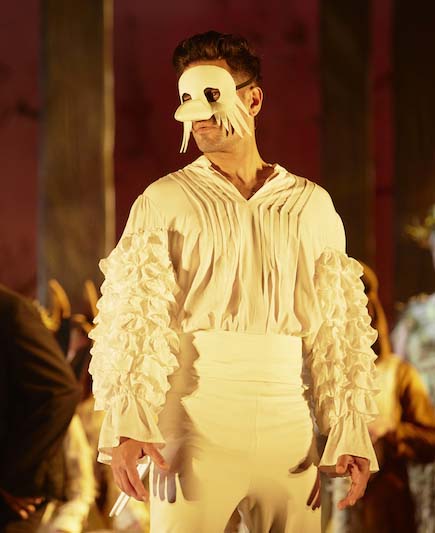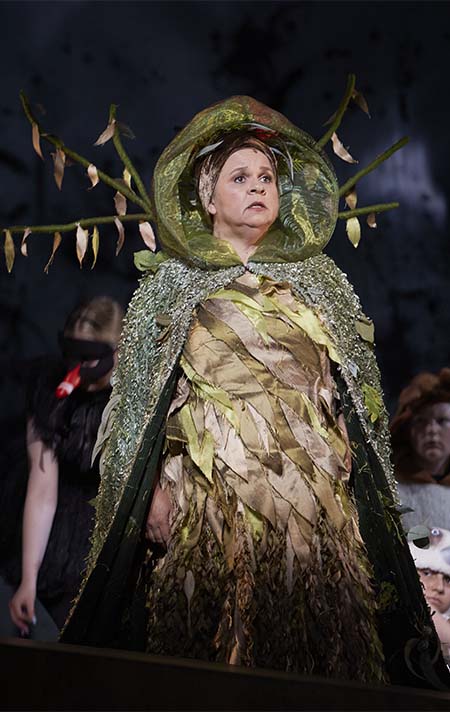A creation story and a powerful First Nations cast provide the perfect vehicle to bring the Noongar tongue to a new audience, as Rosalind Appleby and junior reviewers Emma and Liliane Wadley discover.
Ancient tale carries language revival
4 October 2021
- Reading time • 10 minutesMusic
More like this
- Rewriting tradition with skill and charm
- Close encounter stirs the soul
- The great unknown
Koolbardi wer wardong, WA Opera & Awesome Festival ·
His Majesty’s Theatre, 2 October 2021 ·
What is the best way to revive an endangered language?
Make an opera of course!
It’s not perhaps the first thing you’d think of, but it’s what singer Gina Williams and guitarist Guy Ghouse have done as part of their vision to revive Noongar, a First Nations language unique to southern WA and spoken by fewer than 400 people.
The powerhouse singer-songwriting duo must be two of the busiest musicians around. On the recent long weekend, Williams and Ghouse performed at both the AFL grand final and York Jazz Festival, and they will launch their Noongar songbook next weekend at the Ubud Readers and Writers Festival. All while rehearsing and premiering their groundbreaking new opera.
Koolbardi wer wardong tells the traditional Noongar story of the koolbardi (magpie) and the wardong (crow), set to music and developed in collaboration with the West Australian Opera and Awesome Festival. In a momentous premiere on Saturday night, Australia’s first Aboriginal opera was performed by First Nations singers, under the direction of a First Nations conductor.
Koolbardi wer wardong is an opera for children and their families, told in Noongar with surtitles in English. The dialogue tells the story with clarity and there is a lyrical cadence to the language, which is eminently singable.
Koolbardi and Wardong are brothers who allow their pride to cause estrangement. As the story unfolds, we meet Ngaank Boodja (Mother Earth), a pair of Djidi Djidi (Willy Wagtails) and other birds and animals (children’s chorus) who witness the fight between the brothers that turns them from white birds to black (and white) birds.

Directed by Matthew Reuben James Ward, this simple story of warning which starts around a campfire (set and costumes by Matt McVeigh) takes on operatic proportions as it moves to a river, forest and ultimately to the end of the earth, as the brothers are banished east and west. Noongar lighting designer Mark Howett adds moodiness (I love the glistening water projections) and Noongar movement director Olman Walley’s familiar animal gestures and elegant Noongar dance patterns subtly permeate the stage.
Williams and Ghouse’s heart-tugging melodies are sweet and fun, arranged by Chris Stone who seamlessly blends a jazz band (led by Ghouse on guitar), with the lush expressiveness of the WA Youth Orchestra, conducted by Aaron Wyatt. It’s wonderful music and gives the ancient story a sense of timelessness and depth.
Williams is majestic as Ngaank Boodja, and Noongar performers Jarred Wall (Wardong) and Jarrad Inman (Koolbardi) navigate her wide-ranging songs with huskiness and power. Strutting with both pride and vulnerability, these boys own the stage. Wall’s power ballad as he mourns the relationship breakdown is compellingly warm and exquisitely orchestrated with a bassoon interweaving a lonesome melody. Inman’s cocky “Ngiyarn baal kwobidak (Who’s the prettiest)?” has the audience in stitches with dance moves culminating in a can-can line with dancing fish!
A couple of cheeky Djidi Djidi (Tyrone Brownley and Natasha Eldridge) keep the mood light, bossing and scheming like two baddies straight out of an opera buffa. The children’s chorus, comprising a Noongar Children’s Choir and the West Australian Young Voices, fill the stage as birds, frogs, kangaroos and creeping echidna, their singing adding halos of sound around the soloists.
There’s heart rending sadness as the brothers farewell each other: “We’ll see each other soon … I’ll keep the campfire going”. There are ghostly echoes of the legacy of broken families inflicted on Noongar people since colonial settlement.
The mix of sadness, fun and hopefulness is a potent blend, and I can feel the audience leaning forward collectively to drink it in. There are those laughing heartily as they recognise their language, those too young to read the surtitles but enraptured by the stage, and those old enough to know some of the blood-stained path it took to get here. A Noongar story, told through song, connecting people to each other and our country – opera at its best.
Junior reviewer Emma Wadley, age 10
The opera is about how the magpie and the crow got their colours, and how pride comes before the fall.
The elegant setting of His Majesty’s Theatre was the perfect place for such a grand performance. I could feel the anticipation and excitement building as we entered the foyer.
The show opens with one lady Gina Williams singing a story on a stage. I thought that this is all that we were going to see but I was in for a surprise. She was soon joined by a cast of talented singers and actors who told us the story through songs. It felt a lot like a musical to me.

The story starts with the two main characters – the crow who wanted to go to the river to catch fish, and the magpie who preferred to sleep in because he was never able to catch any fish. In the end, they did go to the river. The magpie didn’t catch any fish while the crow caught many. The magpie was so jealous that he stole the crow’s fish.
The musical variety really brought the story to life. Some songs were funky and upbeat like the jazz number performed when the magpie was handing out the fish he stole – this was my favourite part. Others were slow and soft like the opening song.
The performance by the Noongar Children’s Choir and the West Australian Young Voices was beautiful and impressive.
From Gina Williams’ flamboyant costume to the echidna’s spiky brown coat, our eyes, as well as our ears, were given a feast. My favourites were the purple and blue floating wings of the butterflies and the brown and blue feathers of the kookaburras.
The performers created this show to entertain their audience and I think they succeeded. I recommend this show for children who enjoy stories and comedy. If I had to choose an age group, I would choose five and up.
By the end of the performance, I wanted the show to keep going. l saw the performance with my mother and little sister, and they seemed to enjoy it very much. Judging by the enthusiastic applause, the audience also seemed to appreciate this superb opera.
Junior reviewer Liliane Wadley, age 8
Koolbardi wer Wardong is a story about a crow and a magpie. It was the first opera in Noongar language. This was the first time I have seen an opera and the first time I have been to His Majesty’s Theatre. It was a very fancy venue and made me think that we were going to see a very important show.
The story of the crow and the magpie starts with a lady telling the story in song. It starts with the crow trying to wake up the magpie so that they could go and catch some fish. But the crow caught more fish than the magpie, and the magpie was so upset he stole the fish then he gave them to the other animals. Magpie sang a song that went “Who is the prettiest?”. The willy wagtails came and teased the magpie and crow until they argued and everyone started cheering “Fight, fight, fight!”.
Some of the music was lovely and sweet like a lullaby and other songs were bouncy and happy. During the fight between the magpie and crow the music was tense. The orchestra was led by a conductor and I saw his baton waving all around. In one song there was a guitar which surprised me because usually they don’t play guitars in an opera.
In many scenes there were lots of animals and birds played by children. Native Australian animals such as kangaroos, frogs, echidnas and butterflies filled the stage. As well as the crow and the magpie, there were sulphur crested cockatoos and kookaburras. The frogs, in particular, stood out because they hopped high and the echidnas moved very slowly and gave me the giggles. The colours of the costumes were like the animals in real life.
I really enjoyed the light-hearted and funny scenes. In one part the magpie was dancing with two giant fish. I also enjoyed the part where the magpie is calling to the fish, “Fishy, fishy where are you? I can’t see you”. Both these scenes made me laugh.
Because of the beautiful voices and music and colourful costumes, I think children aged 8 and up would enjoy this show. Younger children might find it a bit difficult to understand. Adults would also enjoy it because they wouldn’t find it too baby-ish.
Koolbardi wer wardong continues until 6 October
Pictured top: Gina Williams commands the stage as Ngaank Boodja. Photo by James Rogers
Like what you're reading? Support Seesaw.






